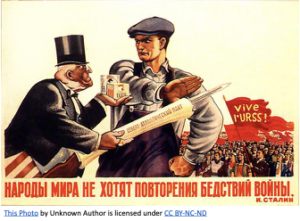by John Katzka
As public affairs officer at the US embassy in Moscow, I had the opportunity during the last years of the Soviet Union to engage with and at times respond to its propaganda efforts. My personal impressions and the conclusions I drew from them form the basis for the observations below.
Whether something constitutes propaganda often depends on your point of view. The Oxford English Dictionary defines propaganda as “information that is often biased or misleading, used to promote a political cause or point of view.” Propaganda, in other words, is not analytical, although it may pretend to be.
It seems to me that any one-sided presentation is in its essence propagandistic. The promotion of US foreign policy may be as propagandistic as that of any other country. Ours is “good” propaganda only because we are on the side of the angels.
There are three overarching influences on the role of propaganda in a particular country: first, that country’s underlying culture; second, its form of government (in the case of Russia, authoritarianism); and third, the role of media-related technology.
Culture and Propaganda
The underlying culture plays a major role in defining what is acceptable. To the traditional elements of culture–language, religion(s), education, and the arts, I would add history, geography, and climate. How did these affect the use of propaganda in the Soviet era and how are they now affecting it in Putin’s Russia?
I believe that there has been continuity in the core values of Russian culture from the Tsars to the Commissars to Putin. These core values stress the needs of the group over those of the individual, a form of zero-sum economics, and the promotion of national security over economic interests. These cultural factors have interacted with an authoritarian political structure that was common to all three eras.
During most of Tsarist history, the state did not have the level of technology required to provide broad dissemination of official propaganda. But it did have a large Russian bureaucracy to assist its efforts, a nascent Russian publishing industry to reach the educated, and the Russian Orthodox religion, more deeply embedded in peasant culture than the state’s bureaucratic apparatus.
The early Soviet leaders were themselves adept propagandists and, recognizing its value, set up a broad network of state media to provide political education. They used propaganda to promote communist party rule, to warn against outside threats, as during World War II (which Soviet propaganda referred to as the Great Patriotic War), and to promote or explain economic development projects, such as the Virgin Lands agricultural fiasco of the late 1950s.

During my first tour in Moscow in the late 1970s, internal propaganda and government policy made it complicated to interact with Soviet citizens. Education played a greater role than the arts in promoting an approved understanding of what it was to be Russian. Indoctrination in the classroom was a given throughout the Soviet period and continues today. The arts had somewhat greater freedom, though the amount varied greatly depending on who was in power. Huge signs with slogans encouraging economic production efforts and warning of the presence of enemies were ubiquitous. Embassy personnel were immediately suspicious of anyone who wanted to be “friends,” and Soviet citizens were equally wary of us. During that period, Soviet agitprop, as it was called, continued to be aggressive and was used externally through “friendly” foreign groups and media outlets.
Geography is often underappreciated in terms of effects on culture. The flat plain that runs from Poland nearly up to Moscow has repeatedly been an invasion route for foreign powers. This affects how Russia looks at its border and how it defines its strategic depth. Throughout its history, the state has used this fear of invasion in its propaganda, internally to keep Russians concerned about external threats, and internationally to justify efforts to recreate that strategic depth, whether by geographic expansion or by acquiring client states, as in Eastern Europe after 1945 or through its current invasion of Ukraine.
Authoritarianism and Propaganda
This quick examination of culture leads to my second point, i.e., the advantages that controlled societies have in using propaganda. Clearly, it is especially effective internally, but it also is used as a tool against adversaries. Allowing that the 1990s largely found Russia suffering from a form of PTSD, the culture remains largely the same under Putin. Yes, I know, there are individuals and groups who left and are leaving who do not accept the current regime. However, that is a factor that accompanied the reigns of many of the Tsars and certainly all the Commissars.

The Cold War was waged with a limited number of states strongly identifying with either the Soviet Union or America. There were a number of other states that tried to stay out of the game. The most obvious example being the Non-Aligned Movement of the 1960s and 70s. Because many of these states were authoritarian, there was at least a bias toward the Soviet Union, making them more willing to accept the Soviet line.
Looking back at Soviet propaganda in the developing world, I remember getting a call from a reporter in Lusaka, Zambia in the early 1980s asking for a comment on a piece that he received from an Indian paper – it was always the same paper. The article embroidered a current issue, turning it into a nasty criticism of the US. On that occasion, I was able to get a quick response from Washington (which did have a Disinformation Office), but on other occasions the Zambians were prepared to believe what we called disinformation. Their cultural sympathies and the fact that at that time they were a one-party state made them more sympathetic to the Soviets.
Technology and Propaganda
In terms of effectiveness and opportunity, internet connectivity and, especially, social media are critical factors that differentiate Putin’s Russia from the Soviet regime.
While the Soviet Union was still on oxygen, during the 1991 coup a new technology, the fax machine, became a factor that upended a power grab by much of the Soviet leadership aiming to overturn the reforms of party and governmental leader Mikhail Gorbachev, then on vacation in Crimea. The coup leaders shut down the newspaper presses and put the media to work supporting the coup. However, Moscow papers sent out fax copies of their papers that were put on many of the reading boards located throughout the city. The aging coup leaders did not understand how this new technology might be used to counter their more traditional attempts to command the instruments of propaganda. These ad hoc fax (and fact) sheets proved more influential than the coup leaders’ command of traditional media in determining how a significant proportion of the people of Moscow reacted to the power grab.
Looking at that Zambian example from the 1980s cited above and looking at the Soviet Union in the early 1990s, traditional media (newspapers, radio, and TV) were the vehicle to reach the people. With social media, outside players can go directly to audiences with their message and there are no journalists to fact check or get another take on the story – a much better propaganda vehicle.
Tsarist Russia, the Soviet Union and the current Russian regime all worked from an authoritarian model. Internal propaganda has been an important component of political control. It is no surprise that they also use this tool internationally and that is likely to continue.
 Authoritarian states face internal challenges as their constituents become better educated. However, in the case of Russia, the education process has remained largely state controlled. So, the role of education as a transforming tool may be less a factor. Historically, they have, as I mentioned earlier, allowed migration to dissipate the dissidents’ effect. Whether they will continue to be able to do so is unclear.
Authoritarian states face internal challenges as their constituents become better educated. However, in the case of Russia, the education process has remained largely state controlled. So, the role of education as a transforming tool may be less a factor. Historically, they have, as I mentioned earlier, allowed migration to dissipate the dissidents’ effect. Whether they will continue to be able to do so is unclear.
The Role of Propaganda: Today and Tomorrow
Russia’s public campaign against the Israeli military action in Gaza may be illustrative of its contemporary propaganda efforts. It uses its own state-controlled and social media to support Hamas, attack Israel, and criticize US policy, while cooperating in these efforts with Iran and to a degree China. Using their worldwide media outlets, the three appear to be amplifying each other. For example, Spanish language Russian TV reposted a statement by Iran’s president calling the Al-Ahli Arab Hospital explosion an Israeli war crime. Similarly, Sputnik India quoted a ‘military expert’ saying, without evidence, that the United States provided the bomb that destroyed the hospital. The New York Times reports that the level of propaganda and disinformation is unprecedented, reflecting the new global bifurcation.
We are in a reshuffling of the international order. The days of two superpowers dominating the international system are long over. The struggle now is not the old ideological mantra – capitalism vs. communism. In this post-Cold War period, we find it uncomfortable to have once supported a ruthless dictator like Mobutu in Zaire because he was not a communist. The line up now is democracies vs. autocracies, with a curious collection of bigger and smaller powers splitting their support to their own advantage. In that environment, the US needs to become more nuanced as we determine who to support and who to oppose.
In this period of propaganda escalation, we will have a difficult time playing outside our democratic rule book. Our open, individualistically oriented society is an easy target for foreign disinformation efforts. Propaganda will be more dynamic, more influential, and more dangerous in the Information Age, especially with the AI explosion of Large Language Models. It is an area where open societies are more vulnerable, and we will need tools to protect ourselves without overreacting. Our foreign policy experience as a nation suggests that we will put our values over our national interests. We will want to preserve our values and occasionally look after our national interests, while continuously measuring their relative costs and consequences.![]()
 Retired Senior Foreign Service officer John Katzka spent the 35 years of his career in Bangkok, Moscow (twice), Lusaka, Belgrade, and Bucharest. John holds a B.A. in International Relations from the University of Wisconsin-Milwaukee. He speaks regularly on foreign affairs to audiences in the greater Milwaukee area and is an avid futurist and co-coordinator of the Milwaukee Chapter of the World Future Society.
Retired Senior Foreign Service officer John Katzka spent the 35 years of his career in Bangkok, Moscow (twice), Lusaka, Belgrade, and Bucharest. John holds a B.A. in International Relations from the University of Wisconsin-Milwaukee. He speaks regularly on foreign affairs to audiences in the greater Milwaukee area and is an avid futurist and co-coordinator of the Milwaukee Chapter of the World Future Society.
